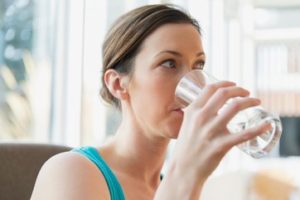
Water: we know we need to drink more of it, and we know it’s the healthiest drink around. Aside from keeping us hydrated, water aids in toxin removal, as well as regulating all of your major organs. It can also help benefit the biggest organ of the body: your skin. While water alone isn’t a treatment measure for skin disorders, getting enough of it on a regular basis can help keep your skin healthy overall. Consider the five major ways water is good for your skin.
1. Hydration to Prevent Skin Problems
Dehydration occurs when your body lacks the water it needs to function properly. According to the Mayo Clinic, your body is made up of about 60 percent of water. Still, you need to drink water in order to replenish lost fluids and to keep every part of your body hydrated. In fact, dehydration can also affect the skin by causing dryness, dullness, and even discoloration.
Coffee—although it contains water—has a diuretic effect which can lead to dehydration if you don’t drink enough plain water. Once you swap other fluids for water, you will likely start to see smoother, supple skin.
2. Increased Blood Flow for a Healthy Glow
In addition to hydrating your major organs, water can also help increase blood flow by removing toxins and helping to spread nutrients: this includes your skin. When you have better blood flow, your skin is more likely to exhibit that “healthy glow” everyone wishes for. In turn, this will also help aging skin look more youthful.
3. Reduced Thinness and Wrinkles
Dehydration coupled with decreased blood flow can also lead to a thin appearance of the skin. When your skin is less supple, it may be prone to more wrinkles. Furthermore, using water-based skincare products can absorb easily into the skin and make your skin look thicker.
4. Improved Skin Cell Turnover
Your skin is naturally evolving every day by shedding old cells and generating new ones. Unfortunately, this process isn’t always perfect. Oils can clog your pores and also trap old skin cells, leaving your skin with dry-looking patches. Drinking water can help improve skin cell turnover by promoting the right oil balance.
Improved skin cell turnover also leads to a correct moisture balance—overtime, you’ll experience softer, less oily skin overall.
5. May Alleviate Skin Discoloration
In most cases, skin discoloration is the result of either a disease of the skin or sun damage. While water can’t necessarily cure skin discoloration, the other benefits can lead to better skin tone. For example, consuming more water may decrease the prevalence of undereye circles and redness of the skin.
Bottom Line: Getting the Right Amount of Water
Drinking water can certainly offer many benefits to the skin, especially when compared with dehydrating beverages like sodas and sugary juices. However, the key to getting all of the benefits for your skin and other organs is to make sure you drink enough of it. The Mayo Clinic advises drinking a total of eight glasses of total fluids per day, at roughly 8 ounces each. You might need more than this on hot days or when you exercise. While other water-containing beverages can count towards your daily intake, swapping these with plain water will be the best plan for your skin.
You should also choose skincare products that contain water over synthetic substances. Water-based products are healthier for your skin, and they also tend to stay put without greasy side effects.
On the flipside, it’s also important that you don’t drink too much water. While the overconsumption of water is largely a rare occurrence, it tends to happen most often in athletes who drink too much water on a regular basis. As long as you are staying properly hydrated, drinking more than the recommended amount won’t do your body—or your skin—any good.
Resources:
- Fetters, K.A. (2015, February 26). Does drinking water really give you glowing skin? Women’s Health Magazine
- Mayo Clinic Staff. (2014, September 5). Water: How much should you drink every day? Retrieved from MayoClinic.org
- The benefits of drinking water for your skin. (2016). Retrieved from UW Health
- Water the magic drink: Learn how it helps glow your skin. (n.d.). Retrieved from Disabled World
Kristeen Cherney is a freelance health and lifestyle writer who focuses on preventive measures for a better quality of life. Cherney holds a BA in Communication, and is currently finishing her MA in English.


- Facebook
- Instagram
- Twitter
- YouTube
- Pinterest
Follow @Honeybee_Grdns